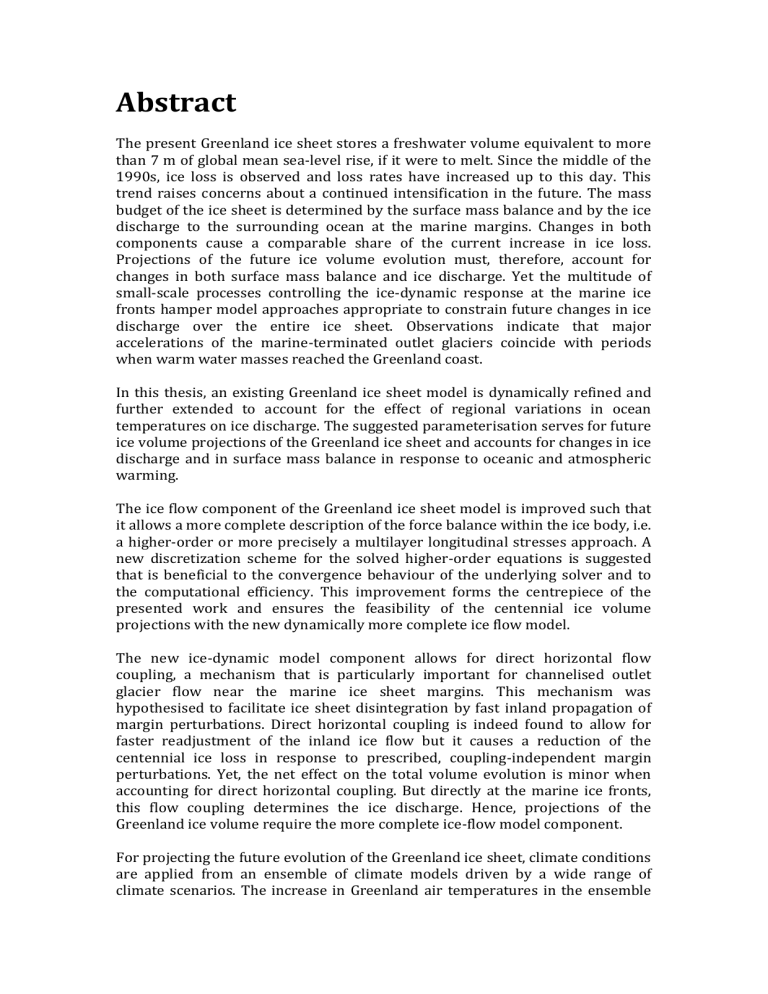
Abstract
The present Greenland ice sheet stores a freshwater volume equivalent to more
than 7 m of global mean sea-level rise, if it were to melt. Since the middle of the
1990s, ice loss is observed and loss rates have increased up to this day. This
trend raises concerns about a continued intensification in the future. The mass
budget of the ice sheet is determined by the surface mass balance and by the ice
discharge to the surrounding ocean at the marine margins. Changes in both
components cause a comparable share of the current increase in ice loss.
Projections of the future ice volume evolution must, therefore, account for
changes in both surface mass balance and ice discharge. Yet the multitude of
small-scale processes controlling the ice-dynamic response at the marine ice
fronts hamper model approaches appropriate to constrain future changes in ice
discharge over the entire ice sheet. Observations indicate that major
accelerations of the marine-terminated outlet glaciers coincide with periods
when warm water masses reached the Greenland coast.
In this thesis, an existing Greenland ice sheet model is dynamically refined and
further extended to account for the effect of regional variations in ocean
temperatures on ice discharge. The suggested parameterisation serves for future
ice volume projections of the Greenland ice sheet and accounts for changes in ice
discharge and in surface mass balance in response to oceanic and atmospheric
warming.
The ice flow component of the Greenland ice sheet model is improved such that
it allows a more complete description of the force balance within the ice body, i.e.
a higher-order or more precisely a multilayer longitudinal stresses approach. A
new discretization scheme for the solved higher-order equations is suggested
that is beneficial to the convergence behaviour of the underlying solver and to
the computational efficiency. This improvement forms the centrepiece of the
presented work and ensures the feasibility of the centennial ice volume
projections with the new dynamically more complete ice flow model.
The new ice-dynamic model component allows for direct horizontal flow
coupling, a mechanism that is particularly important for channelised outlet
glacier flow near the marine ice sheet margins. This mechanism was
hypothesised to facilitate ice sheet disintegration by fast inland propagation of
margin perturbations. Direct horizontal coupling is indeed found to allow for
faster readjustment of the inland ice flow but it causes a reduction of the
centennial ice loss in response to prescribed, coupling-independent margin
perturbations. Yet, the net effect on the total volume evolution is minor when
accounting for direct horizontal coupling. But directly at the marine ice fronts,
this flow coupling determines the ice discharge. Hence, projections of the
Greenland ice volume require the more complete ice-flow model component.
For projecting the future evolution of the Greenland ice sheet, climate conditions
are applied from an ensemble of climate models driven by a wide range of
climate scenarios. The increase in Greenland air temperatures in the ensemble
reaches up to 11˚C within the coming century while offshore ocean warming at
intermediate depth remains below 5˚C. By 2100, all projections show regional
warming in the ocean and the atmosphere, causing ice loss on Greenland. The
sea-level contribution from the ice sheet reaches a centennial maximum of 16.6
cm for the high-emission scenario. For the low impact scenario, for which the
warming trajectory peaks already within this century, a minimum centennial ice
loss of 1.4 cm is attainable. The ensemble average ice loss for the high and lowimpact scenarios is equivalent to respectively 10.2 and 4.5 cm of global sea level.
On the long run, only the low-impact scenario causes a volume trajectory with
declining loss rates by 2300. Such a decline is necessary if the aim is to preserve
a future Greenland ice sheet with comparable size than at present. For a more
moderate mitigation scenario, the centennial ensemble ice loss is 5.5 cm and loss
rates remain virtually constant thereafter even though the warming trend
already abates. By 2300, ice equivalent to 20.1 cm is lost on average and it
remains uncertain if the ice sheet is sustainable even for the moderate, global
warming of 2.2˚C in this scenario.
Though the increase in ice discharge over the last decade explains about half of
the inferred total ice loss increase, which is reproduced by the ice-sheet model,
the relative importance of future changes in ice discharge ultimately decreases.
The decreasing importance for total mass loss mainly arises from the dominant
increase in surface melting under future warming. But ice discharge is further
limited by thinning and retreat of the ice sheet margin. The different balance of
processes causing ice loss in the future implies that the inferred mass loss record
over the last few decades should not serve as sole basis for extrapolation.
Samenvatting
In zijn huidige vorm herbergt de Groenlandse ijskap een zoetwatervolume dat bij
een totaal afsmelten zou leiden tot een wereldwijde zeespiegelstijging van meer
dan 7 meter. Waarnemingen wijzen op een steeds groter wordend jaarlijks
verlies van ijsvolume sinds het midden van de jaren ’90. Deze trend leidt tot
ongerustheid over een toekomstige verscherping van het massaverlies. De
massabalans van de ijskap wordt bepaald door twee factoren: enerzijds door de
massabalans aan de oppervlakte, met name het verschil tussen accumulatie en
ablatie, en anderzijds door de ijsafvoer aan de mariene rand van de ijskap,
voornamelijk door het afkalven van ijsbergen in zogenaamde outlet gletsjers.
Gedurende de laatste twee decennia hebben veranderingen in deze beide
componenten ongeveer in gelijke mate bijgedragen tot het toenemende
ijsverlies. Prognoses omtrent de toekomstige evolutie van het ijsverlies op
Groenland moeten dan ook rekening houden met de verandering van deze twee
componenten. Een modelbenadering op ijskapschaal om de toekomstige evolutie
van de ijsafvoer te modelleren wordt echter bemoeilijkt door het veelvoud aan
kleinschalige processen die de ijsdynamica aan de mariene ijskaprand
controleren. Observaties tonen aan dat dynamische versnellingen van outlet
gletsjers gepaard gaan met periodes waarin warmere watermassa’s de
Groenlandse kust bereikten.
In deze thesis wordt een reeds bestaand ijskapmodel voor Groenland verder
ontwikkeld, waarbij de nadruk voornamelijk ligt op de ijsdynamische
component. Bovendien wordt een parameterisatie voorgesteld die de invloed
van veranderingen in oceaantemperatuur op de ijsafvoer bepaalt. Deze
parameterisatie wordt vervolgens gebruikt om de toekomstige evolutie in de
Groenlandse ijskap, die wordt bepaald door veranderingen in ijsafvoer alsook in
de oppervlaktemassabalans, te simuleren.
De ijsdynamische component van het Groenlandse ijskapmodel werd verbeterd
zodat het een volledigere beschrijving van het evenwicht tussen de interne
krachten toelaat. Concreet houdt de nieuwe benadering van het evenwicht nu
ook rekening met verticale verschillen in de longitudinale spanningsvelden in
het ijs. Voor het stelsel van vergelijkingen werd een nieuwe discretisatie
gebruikt, wat zowel het convergentiegedrag van de numerieke
oplossingsprocedure als de efficiëntie van het programma verbetert. Het nieuwe
model laat een meer realistische beschrijving van de ijsvloei in outlet gletsjers
toe en de numerieke verbetering stelt ons in staat om simulaties voor de
Groenlandse ijskap op 100-jarige tijdschaal uit te voeren.
De nieuwe ijsdynamische modelcomponent houdt bovendien rekening met
eenrechtstreekse, horizontale koppeling van de ijsvloei. Dit mechanisme is van
groot belang voor het ijstransport in outlet gletsjers nabij de mariene randen van
de ijskap. Er wordt verondersteld dat dit mechanisme de desintegratie van de
ijskap ondersteunt door een mogelijk snelle landinwaartse verspreiding van
marginale verstoringen. Deze horizontale koppeling vereenvoudigt inderdaad de
binnenlandse aanpassing van de ijsvloei en de ijsgeometrie, maar vermindert
wel het ijsverlies veroorzaakt door koppelings-onafhankelijke perturbaties aan
de rand van de ijskap. Het netto-effect van de ijsvloeikoppeling op de evolutie
van het ijsvolume is desondanks gering. Aan de mariene ijsfronten is de
horizontale koppeling nochtans van groot belang omdat deze de ijsafvoer
bepaalt, wat op zijn beurt cruciaal is voor toekomstige projecties van het
ijsvolume.
Om de toekomstige evolutie van de ijskap te bepalen, worden de klimatologische
omstandigheden voorgeschreven aan de hand van een spectrum aan
klimaatmodellen die worden aangedreven door meerdere klimaatscenario’s. In
het meest extreme scenario neemt de luchttemperatuur over Groenland toe met
11˚C gedurende de 21ste eeuw, terwijl de omliggende oceaan maximaal 5˚C
opwarmt op middelmatige diepte. Tegen 2100 vindt er in alle klimaatprojecties
een regionale opwarming van de oceaan en van de atmosfeer plaats, wat leidt tot
een verlies aan landijs. De zeespiegelstijging bereikt, door het smelten van de
ijskap voor het hoogste emissiescenario, een maximale waarde van 16,6 cm over
een periode van 100 jaar. Bij het lage impactscenario piekt de temperatuur reeds
in de 21ste eeuw en is het verlies van ijs beperkt tot minimaal 1,4 cm over 100
jaar. Het gemiddelde ijsverlies voor de verschillende klimaatmodellen voor de
laagste en hoogste opwarmingsscenario’s zijn respectievelijk 4,5 en 10,2 cm.
Enkel bij het lage impactscenario neemt het tempo van het ijsverlies af tegen het
einde van de 23ste eeuw. Een dergelijke afname zet aan tot een langdurige
stabilisatie van de ijskap met een vergelijkbare geometrie als de huidige ijskap.
Voor een matiger klimaatscenario loopt het gemiddelde ijsverlies op tot 5,5 cm
na 100 jaar. Daarna blijft het jaarlijkse massaverlies nagenoeg constant, hoewel
de opwarmingstrend al afneemt. Tegen 2300 zal het verloren ijsvolume gelijk
zijn aan 20,1 cm globale zeespiegelstijging en het is onduidelijk of de
Groenlandse ijskap kan blijven bestaan onder de matige, globale opwarming van
2,2˚C in dit scenario.
Ondanks het feit dat de extra ijsafvoer over het laatste decennium nog de helft
van de toename in het totale ijsverlies verklaart, hetgeen ook door ons model
wordt gereproduceerd, zal het relatieve belang van deze component in de
toekomst afnemen. Dit wordt enerzijds verklaard door de dominante rol van
oppervlakteafsmelting in een warmer klimaat en anderzijds ook door een
afname in ijsdikte en terugtrekking van de mariene rand van de ijskap. Deze
interactie tussen processen die leiden tot een massaverlies en de manier waarop
hun interne verhouding verandert met de tijd, toont aan dat huidige
massaverliezen niet kunnen worden geëxtrapoleerd naar de toekomst toe om
realistische prognoses te maken.










